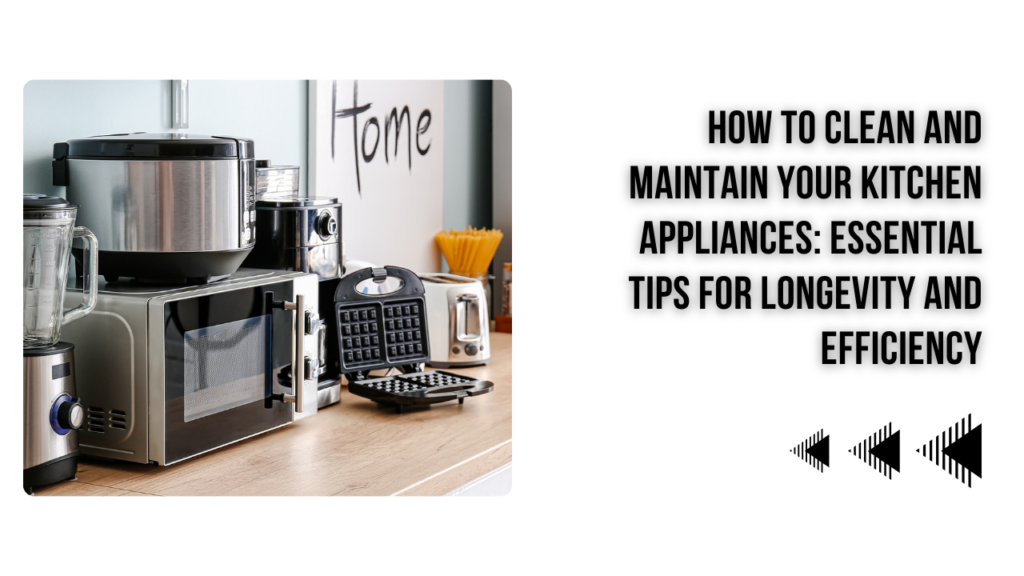Introduction
This is not only for maintaining appliances for longer use, but their operating efficiency is highly important; it prevents rough and unhygienic cooking of meals. The good thing about the following regular cleaning and maintenance practices is that they will prevent various problems from occurring and extend the appliances’ operating life. Herein, the aim of the subsequent guide is to offer general tips and practices on how different kitchen appliances can be cleaned and cared for to remain in good condition.
1. General Cleaning Tips
a. Safety First
- Unplug Appliances: Always unplug the appliances before cleaning to avoid electrical hazards.
- Read Manuals: Refer to manufacturer’s manuals for specific cleaning instructions and recommendations.
b. Use the Right Cleaners
- Non-Abrasive Cleaners: Opt for non-abrasive cleaners to avoid scratching surfaces.
- Avoid Harsh Chemicals: Steer clear of harsh chemicals that can damage appliance finishes.
c. Regular Cleaning Routine
Daily wipe down of the appliance to avoid grime and food particle buildup.
Deep cleaning: Plan deep cleaning sessions as needed, depending on appliance usage and appliance type.
2. Cleaning and Maintenance for the Various Kitchen Appliances
a. Refrigerator
i. Interior Cleaning
Everything in the refrigerator needs to be taken out.
Cleaning Shelves: Shelves and drawers should be soaked in soapy warm water. Should be totally dried out and replaced.
Clean the interior walls: mix baking soda with water to neutralize odors.
ii. Exterior Cleaning
Wipe down the exterior with a wet cloth, making sure to include the door handles.
Stainless Steel If it is a stainless steel model, then you will need to apply a stainless steel cleaner to make sure it retains its glow of shine.
iii. Coils and Filters
- Vacuum Coils: Every six months, the condenser coils need to be vacuumed because dust and dirt accumulate, making it run less efficiently and cool worse.
- Clean Water Filter: If a refrigerator has a water filter, clean or replace it according to the manufacturer’s suggestions.
b. Oven
i. Interior Cleaning
- Self-Cleaning Mode: If it has a self-cleaning mode, make use of it. The instructions from the manufacturer are to be followed with precision and there is good ventilation.
Manual Cleaning: The interior of non-self-cleaning ovens should be cleaned using baking soda and water. No harsh chemicals are to be used inside an oven because they can damage it.
ii. Racks and Trays
Remove and Clean: Oven racks and trays are to be removed. Soak them in warm, soapy water, scrub with a non-abrasive sponge, and then set them out to rinse.
iii. Exterior Cleaning
Clean the exterior with a damp cloth with mild detergent. In the case of stainless steel, use a dedicated stainless steel cleaner.
c. Microwave
i. Interior Cleaning
Steam Cleaning: Place a bowl of water with lemon slices or vinegar inside the microwave. Heat on high until steam forms to help loosen grime. Wipe the interior with a damp cloth.
- Turntable: Remove the turntable and its support and wash them in warm soapy water.
ii. Exterior Cleaning
- Wipe Down: Wipe down the exterior with a moist cloth and mild detergent. Avoid letting water seep into the ventilation areas.

d. Dishwasher
i. Interior Cleaning
- Run a Cleaning Cycle: Run an empty cleaning cycle with either a dishwasher cleaner or a cup of white vinegar.
Clean Filters: Take out and clean the filters so that they may not clog up and Work ideally.
ii. Exterior Cleaning
Wipe Down: The exterior needs to be wiped down with a wet cloth using mild detergent. Stainless steel models need to be cleaned with a stainless steel cleaner so that the shine lasts.
e. Coffee Maker
i. Interior Cleaning
- Descaling: Do a descaling with a solution for that purpose or a mixture of vinegar and water to rid the machine of mineral buildup. Run this solution under a brew cycle, followed by several cycles of fresh water for rinsing.
- Clean Removable Parts: Removable parts like the carafe and filter basket should be washed with warm, soapy water.
ii. Cleaning the Exterior
- Wipe Down: Wipe down the exterior with a damp cloth. Be careful not to expose any of the electrical parts to water.
f. Toaster
i. Crumb Tray
- Empty Crumb Tray: Remove and empty the crumb tray from time to time to prevent accumulation that can lead to fire.
- Clean: Wash in warm water using soap. Dry it thoroughly before returning it to its place.
ii. Exterior Cleaning
- Wipe Down: The exterior should be wiped with a wet cloth. For stubborn stains, use a mild detergent. Be careful not to let water drip inside the toaster.
g. Blender and Food Processor
i. Cleaning
- Take Apart: Remove the blade assembly and other removable parts.
- Clean: Soak the parts in warm, soapy water. For stains, a mixture of baking soda and water might be used. Then let them dry completely.
ii. Cleaning of Exterior
- Wipe Off: Wipe off the exterior with a wet cloth. For any sticky area, a light cleaner may be used.
3. Long Life Maintenance Tips
**a. Seasonal Check Up
- Check for Wear: Appliance wear and tear should be checked often. Issues observed should be addressed immediately to avoid further damage.
b. Proper Usage
- Follow Instructions: Equipment use is strictly according to the manufacturer’s instructions to avoid misuse and eventual destruction.
- Avoid Overloading: One should not overload the appliances; this makes the motor work harder, hence decreasing efficiency.
**c. Professional Servicing
- Schedule Servicing: With complicated problems or in need of regular maintenance, consider professional servicing to ensure appliances are running properly.
4. Eco-Friendly Cleaning Practices
a. Natural Cleaners
- Baking Soda: Baking soda is great due to its natural abrasiveness and the capability it possesses in eliminating odors.
- Vinegar: Vinegar is an excellent natural cleaner for taking out grease and mineral deposits.
b. Reduce Waste
- Reusable Cloths: Use washable cleaning cloths instead of paper disposable wipes.
Environmentally friendly products: There are numerous environmentally friendly cleaning products that do not cause harm to the environment. Conclusion Proper cleaning and maintenance of your appliances ensure longevity and efficiency of those appliances. By continuing with the tips and best practices outlined in the guide, you will be guaranteed your appliances remain at their best, thereby upholding the performance and increasing the life span.
For more information and resources on keeping your kitchen appliances in good condition, besides information on other house-related topics, log onto currentedu365.in. The website provides very helpful tips and ideas about how to take care of your home and all the appliances in it.
Taking Care of the Kitchen Appliances for a Cleaner Environment of Cookings.



